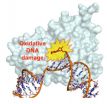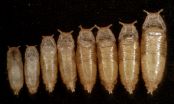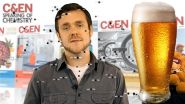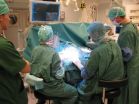(Press-News.org) Using a new imaging technique, National Institutes of Health researchers have found that the biological machinery that builds DNA can insert molecules into the DNA strand that are damaged as a result of environmental exposures. These damaged molecules trigger cell death that produces some human diseases, according to the researchers. The work, appearing online Nov. 17 in the journal Nature, provides a possible explanation for how one type of DNA damage may lead to cancer, diabetes, hypertension, cardiovascular and lung disease, and Alzheimer's disease.
Time-lapse crystallography was used by National Institute of Environmental Health Sciences (NIEHS) researchers to determine that DNA polymerase, the enzyme responsible for assembling the nucleotides or building blocks of DNA, incorporates nucleotides with a specific kind of damage into the DNA strand. Time-lapse crystallography is a technique that takes snapshots of biochemical reactions occurring in cells.
Samuel Wilson, M.D., senior NIEHS researcher on the team, explained that the damage is caused by oxidative stress, or the generation of free oxygen molecules, in response to environmental factors, such as ultraviolet exposure, diet, and chemical compounds in paints, plastics, and other consumer products. He said scientists suspected that the DNA polymerase was inserting nucleotides that were damaged by carrying an additional oxygen atom.
"When one of these oxidized nucleotides is placed into the DNA strand, it can't pair with the opposing nucleotide as usual, which leaves a gap in the DNA," Wilson said. "Until this paper, no one had actually seen how the polymerase did it or understood the downstream implications."
Wilson and his colleagues saw the process in real time, by forming crystal complexes made of DNA, polymerase, and oxidized nucleotides, and capturing snapshots at different time points through time-lapse crystallography. The procedure not only uncovered the stages of nucleotide insertion, but indicated that the new DNA stopped the DNA repair machinery from sealing the gap. This fissure in the DNA prevented further DNA repair and replication, or caused an immediate double-strand break.
"The damaged nucleotide site is akin to a missing plank in a train track," Wilson said. "When the engine hits it, the train jumps the track, and all of the box cars collide."
Large numbers of these pileups and double-strand breaks are lethal to the cell, serving as a jumping off point for the development of disease. However, it can be a good thing if you are a researcher trying to destroy a cancer cell.
"One of the characteristics of cancer cells is that they tend to have more oxidative stress than normal cells," said Bret Freudenthal, Ph.D., lead author of the paper and postdoctoral fellow in Wilson's group. "Cancer cells address the issue by using an enzyme that removes oxidized nucleotides that otherwise would be inserted into the genome by DNA polymerases. Research performed by other groups determined if you inhibit this enzyme, you can preferentially kill cancer cells."
Wilson and Freudenthal stressed that the quantities of oxidized nucleotides in the nucleotide pool are usually under tight control, but if they accumulate and start to outnumber undamaged nucleotides, the DNA polymerase adds more of them to the strand. Molecules that inhibit oxidation, known as antioxidants, reduce the level of oxidized nucleotides, and may help prevent some diseases.
INFORMATION:
Reference: Freudenthal BD, Beard WA, Perera L, Shock DD, Kim T, Schlick T, Wilson SH. 2014. Uncovering the polymerase-induced cytotoxicity of an oxidized nucleotide. Nature; doi:10.1038/nature13886 [Online 17 November 2014].
Grant numbers:
Z01ES050158
Z01ES050161
ZICES043010
U19CA105010
NIEHS supports research to understand the effects of the environment on human health and is part of NIH. For more information on environmental health topics, visit http://www.niehs.nih.gov. Subscribe to one or more of the NIEHS news lists to stay current on NIEHS news, press releases, grant opportunities, training, events, and publications.
About the National Institutes of Health (NIH): NIH, the nation's medical research agency, includes 27 Institutes and Centers and is a component of the U.S. Department of Health and Human Services. NIH is the primary federal agency conducting and supporting basic, clinical, and translational medical research, and is investigating the causes, treatments, and cures for both common and rare diseases. For more information about NIH and its programs, visit http://www.nih.gov.
NIH...Turning Discovery Into Health ®
PHILADELPHIA (Nov. 25, 2014) - As the linked epidemics of obesity and diabetes continue to escalate, a staggering one in five U.S. adults is projected to have diabetes by 2050.
Ground zero for identifying ways to slow and stop that rise is Philadelphia, which has the highest diabetes rate among the nation's largest cities. For public health researchers at Drexel University, it is also a prime location to learn how neighborhood and community-level factors -- not just individual factors like diet, exercise and education-- influence people's risk.
A new Drexel study published ...
PITTSBURGH, Nov. 24, 2014 -Barriers to the sharing of public health data hamper decision-making efforts on local, national and global levels, and stymie attempts to contain emerging global health threats, an international team led by the University of Pittsburgh Graduate School of Public Health announced today.
The analysis, published in the journal BMC Public Health and funded by the Bill & Melinda Gates Foundation and the National Institutes of Health (NIH), classifies and examines the barriers in order to open a focused international dialogue on solutions.
"Data on ...
The proper regulation of body size is of fundamental importance, but the mechanisms that stop growth are still unclear. In a study now published in the scientific journal eLife*, a research group from Instituto Gulbenkian de Ciência (IGC), led by Christen Mirth, shed new light on how animals regulate body size. The researchers uncovered important clues about the molecular mechanisms triggered by environmental conditions that ultimately affect final body size. They show that the timing of synthesis of a steroid hormone called ecdysone is sensitive to nutrition in the ...
People's views on income inequality and wealth distribution may have little to do with how much money they have in the bank and a lot to do with how wealthy they feel in comparison to their friends and neighbors, according to new findings published in Psychological Science, a journal of the Association for Psychological Science.
"Our research shows that subjective feelings of wealth or poverty motivate people's attitudes toward redistribution, quite independently of objective self-interest," says psychological scientist and study co-author Keith Payne of the University ...
WASHINGTON, Nov. 25, 2014 -- Your beer may attract annoying fruit flies, but listen up before you give them a swat. Researchers found the yeast cells in beer are producing odor compounds -- acetate esters -- that lure flies and that could lead to the best beer you haven't even tasted yet. This week's Speaking of Chemistry explains why. Check it out at http://youtu.be/HQNlGuZvCvA.
Speaking of Chemistry is a production of Chemical & Engineering News, a weekly magazine of the American Chemical Society. The program features fascinating, weird and otherwise interesting chemistry ...
Bitcoin is the new money: minted and exchanged on the Internet. Faster and cheaper than a bank, the service is attracting attention from all over the world. But a big question remains: are the transactions really anonymous? Several research groups worldwide have shown that it is possible to find out which transactions belong together, even if the client uses different pseudonyms. However it was not clear if it is also possible to reveal the IP address behind each transaction. This has changed: researchers at the University of Luxembourg have now demonstrated how this is ...
The study at Sahlgrenska Academy, University of Gothenburg, was based on the Swedish National Epilepsy Surgery Register, which includes all cases since 1990. The researchers reviewed data for the 865 patients who were operated on at Sweden's six epilepsy surgery clinics from 1996 to 2010.
The purpose of surgery is to enable a person with severe epilepsy to be free of seizures or to reduce their frequency to the point that (s)he can enjoy better quality of life.
Downward trend
Only 3% (25) of the patients suffered lasting complications. A comparison with a previous ...
Researchers at KU Leuven's Centre for Surface Chemistry and Catalysis have successfully converted sawdust into building blocks for gasoline. Using a new chemical process, they were able to convert the cellulose in sawdust into hydrocarbon chains. These hydrocarbons can be used as an additive in gasoline, or as a component in plastics. The researchers reported their findings in the journal Energy & Environmental Science.
Cellulose is the main substance in plant matter and is present in all non-edible plant parts of wood, straw, grass, cotton and old paper. "At the molecular ...
Results presented November 19 by University of Colorado Cancer Center investigator Daniel Pollyea, MD, MS, at the 26th European Organisation for Research and Treatment of Cancer Symposium in Barcelona show "extremely promising" early phase 1 clinical trial results for the investigational drug AG-120 against the subset of patients with acute myeloid leukemia (AML) harboring mutations in the gene IDH1. The finding builds on phase 1 results of a related drug, AG-221, against IDH2 mutations, presented at the most recent meeting of the American Association for Cancer Research. ...
After mining the genetic records of thousands of breast cancer patients, researchers from the Johns Hopkins Kimmel Cancer Center have identified a gene whose presence may explain why some breast cancers are resistant to tamoxifen, a widely used hormone treatment generally used after surgery, radiation and other chemotherapy.
The gene, called MACROD2, might also be useful in screening for some aggressive forms of breast cancers, and, someday, offering a new target for therapy, says Ben Ho Park, M.D., Ph.D., an associate professor of oncology in the Kimmel Cancer Center's ...




